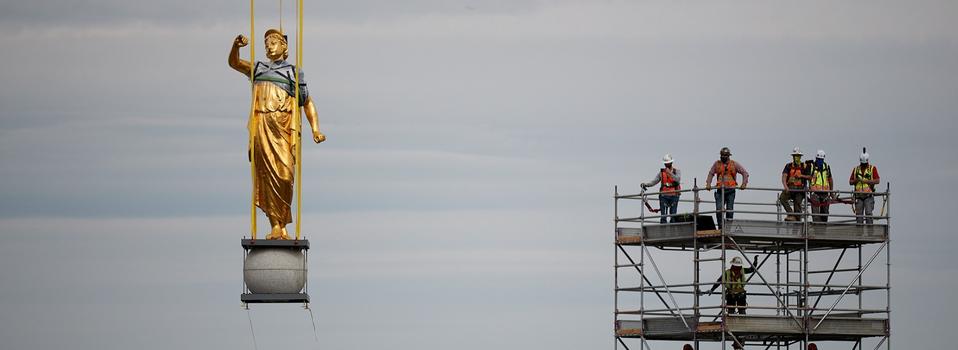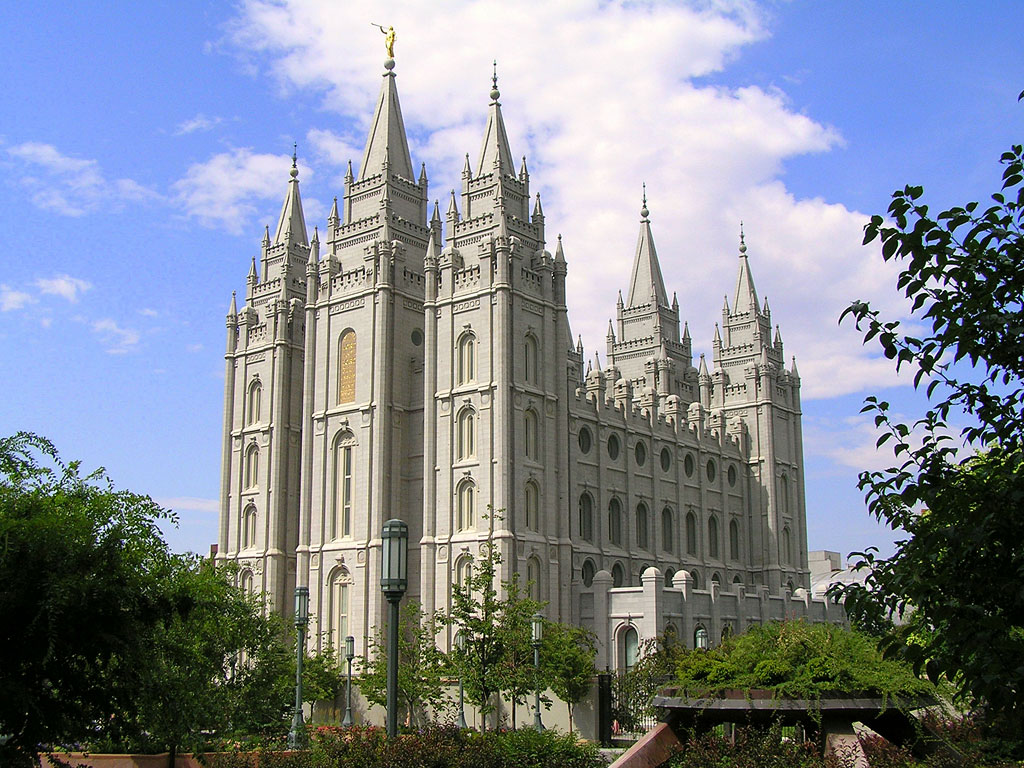
Daniel Woodruff, spokesperson for The Church of Jesus Christ of Latter-day Saints, released the following statement to the media on the morning of May 18, 2020:
This morning, crews on Temple Square are working to remove the angel Moroni statue and capstone which stand atop the Salt Lake Temple. This has long been planned as part of the temple renovation, but the timeline to do so was accelerated following the earthquake in March. The statue and capstone will be preserved and refurbished before being reinstalled at a later date. Work also continues to remove stones from the upper spires of the temple for preservation during the project. Those stones will be reinstalled in the future.
“The Salt Lake Temple is the house of the Lord, and it is being shored up and strengthened to be able to stand for generations to come,” said Andy Kirby, director of historic temple renovations. “Each aspect of this project plays an important role in helping this sacred structure to remain a symbol of permanence, optimism, and faith for people around the world.”
The removal of the statue and capstone had long been planned as part of the temple’s years-long structural and seismic renovation. The timeline for this portion of the project was sped up following a 5.7 magnitude earthquake in March 2020 that shook the trumpet out of Moroni’s right hand and caused other minor damage.
Salt Lake Temple Facts

The Salt Lake Temple was the fourth temple built in Utah (though its construction was started first) and the first built in the Salt Lake Valley.
The Salt Lake Temple was the only temple dedicated by President Wilford Woodruff.
With its distinctive spires and statue of the angel Moroni, the Salt Lake Temple is an international symbol of the Church.
The Salt Lake Temple is the largest temple (most square footage) of the Church.
The building of the Salt Lake Temple was seen as a fulfillment of the prophet Isaiah’s prophecy: “And it shall come to pass in the last days, that the mountain of the Lord’s house shall be established in the top of the mountains, and shall be exalted above the hills; and all nations shall flow unto it” (Isaiah 2:2).
Brigham Young said of the Salt Lake Temple: “I want to see the temple built in a manner that it will endure through the Millennium.”
The Salt Lake Temple took 40 years to build with its highly ornate interior being completed in just a year. (View the story of the building of the Salt Lake Temple.)
The walls of the Salt Lake Temple are nine feet thick at the base and six feet thick at the top. Brigham Young had originally favored building the walls from adobe with a thin veneer of stone, which would require very thick walls, but the decision was later made to use solid hand-carved pieces of granite of the same thickness.
Original plans for the Salt Lake Temple called for two angel Moroni statues—one on the east central spire and one on the west.
The Salt Lake Temple is the first temple to feature a standing angel Moroni statue, which is 14-feet tall and attached to a rod that extends 27 feet into the tower, terminating with a 4,000-pound counterbalance to keep the statue immovable. The angel was created by Paris-trained sculptor Cyrus E. Dallin and built in Salem, Ohio.
The Salt Lake Temple features beautiful hand-painted murals on the walls of its progressive-style ordinance rooms: Creation Room, Garden Room, World Room, Terrestrial Room (no murals), and Celestial Room (no murals). The Creation Room murals were not added until 1915 when Church member Frithjof Weberg of Norway was commissioned with the task; the walls had previously been white.
The Salt Lake Temple is one of only seven temples where patrons progress through four ordinance rooms before passing into the Celestial Room. (The other six temples are the Manti Utah Temple, the Laie Hawaii Temple, the Cardston Alberta Temple, the Idaho Falls Idaho Temple, the Los Angeles California Temple, and the Nauvoo Illinois Temple.)
The Salt Lake Temple is one of two temples that still employ live acting for presentation of the endowment. (The other is the Manti Utah Temple.)
The Salt Lake Temple was completed the afternoon before the dedication. That evening, invited government officials, businessmen, and their wives were given a complete tour of the temple. It was the first time that a temple had been opened to the public prior to its dedication.
The Salt Lake Temple was dedicated on April 6, 1893—three years before Utah became a state in 1896.
The Salt Lake Temple was closed on July 29, 1962 for extensive renovation that included demolition of the old annex; cleaning of the exterior stone; replacement or upgrade of all mechanical systems, plumbing, wiring, carpeting, and light fixtures; reupholstering of furniture; and redecoration of the entire building. The temple reopened on May 21, 1963.
The dedication of a temporary annex was held on March 7, 1963. This building would later become the North Visitors’ Center.
The new annex opened on March 19, 1966. It was built to house seven new sealing rooms, a children’s waiting room, mechanical systems, two new locker rooms, new initiatory areas, and a new chapel seating 450 patrons. The annex was formally dedicated on October 23, 1967.
On August 13, 1993, the contents of the Salt Lake Temple record stone—a hollow stone in the foundation—were removed 136 years after they were originally placed there by Brigham Young and other leaders. Items placed in the stone included books, pamphlets, periodicals, and a set of Deseret gold coins. Because the stone had cracked, the paper items were severely damaged by moisture. Salvaged materials are now housed in the Church History Library.
On March 18, 2020, a 5.7-magnitude earthquake struck the Salt Lake Valley during the renovation of the Salt Lake Temple, causing the trumpet to be shaken from the grasp of the angel Moroni statue and land on the tower roof.
Temple Symbolism
Rich symbolism adorns the exterior of the Salt Lake Temple, depicting mankind’s journey from mortality into the eternal realms. Perhaps Elder J. Golden Kimball expressed it best when he stated: “When I think about that building, every stone in it is a sermon to me.”1 Following is a summary of some of the major symbolism of the Salt Lake Temple:
Angel Moroni. The angel Moroni depicts both a messenger of the restoration of the gospel and a herald of the Second Coming: “for the Son of Man shall come, and he shall send his angels before him with the great sound of a trumpet, and they shall gather together the remainder of his elect from the four winds” (JS-M 1:37).
Towers. The three towers on the east side represent the First Presidency of the Church and the Melchizedek Priesthood; the twelve pinnacles rising from the towers represent the Twelve Apostles. The three towers on the west side represent the Presiding Bishopric and the Aaronic Priesthood; the twelve pinnacles rising from the towers represent the High Council.
Battlements. The castle-like battlements that surround the temple symbolize a separation from the world as well as a protection of the holy ordinances practiced within its walls.
Earthstones. The earthstones, located at the base of each buttress, represent the earth—the “footstool of God.” Although the earth is currently a telestial kingdom, it will transition to a terrestrial kingdom at the coming of the Millennium; and at the end of one thousand years, it is destined to become a celestial kingdom.
Moonstones. Located directly above the earthstones, the moon is depicted in its various phases around the temple. The changing moon can represent the stages of human progression from birth to resurrection or represent the patron’s journey from darkness to light.
Sunstones. Located directly above the moonstones, the sunstones depict the sun—a symbol of the glory of the celestial kingdom.
Cloudstones. High above the sunstones on the east center tower are two clouds with descending rays of light (originally planned to be one white and one black with descending trumpets.) The parallel of this symbolism is found in the Old Testament. Once temples were dedicated in ancient Israel, they were filled with the “cloud of the Lord.” At Mount Sinai, the children of Israel saw this cloud as both dark and bright accompanied by the blasting of a trumpet.
Starstones. Six-pointed stars represent the actual stars in the heaven. Upside-down five-pointed stars represent morning stars, compared to the “sons of God” in the scriptures. The large upright five-pointed stars may represent the governing power of the priesthood while the small upright five-pointed stars may represent the saving power of the priesthood for those who attach themselves to it.
Big Dipper. High on the west center tower is a depiction of the Big Dipper, a constellation used by travelers for thousands of years to find the North Star. It is an appropriate symbol for the temple where patrons come to get their bearings on the journey home.
Handclasp. Each of the center towers features a pair of clasped right hands identified as the “right hands of fellowship” cited in Galatians 2:9. In Jeremiah 31:32, the Lord uses the handclasp to denote covenant making—an act at the very heart of temple worship.
All-Seeing Eye. Located atop each of the center towers of the temple is the all-seeing eye of God, which represents God’s ability to see all things. (From ChurchofJesusChrist.org)
